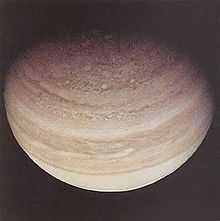JunoCam


JunoCam (or JCM) is the visible-light camera/telescope of the Juno Jupiter orbiter, a NASA space probe to the planet Jupiter launched on 5 August 2011. It was built by Malin Space Science Systems.[1]
Juno's planned orbit is highly elongated[2] and takes it close to the poles (within 4,300 kilometres (2,700 mi)), but then far beyond Callisto's orbit, the most distant Galilean moon.[2] This orbital design helps the spacecraft (and its complement of scientific instruments) avoid Jupiter's radiation belts, which have a record of damaging spacecraft electronics and solar panels.[2] The 'Juno Radiation Vault', with titanium walls, will also aid in protecting and shielding Juno's electronics.[3]
To better understand the Juno orbit parameters, one must take into account what was learned about radiation in the Jovian system with the Galileo mission. The Galileo probe to Jupiter, which was in an equatorial orbit,[2] had to endure over 20 radiation anomalies, exceeding its design limit by at least a factor of three.[4] In comparative terms, Juno will clearly receive much less high levels of radiation than the Galileo craft.
Due to telecommunications constraints, Juno will only be able to return about 40 megabytes of camera data during each 11-day orbital period. This will limit the number of images that are captured and transmitted during each orbit to somewhere between 10 and 1000.[5] This may be comparable to the Galileo mission, which captured thousands of images[6] despite its slow data rate.
Design origins
The JunoCam physical and electronic interfaces are largely based on the MARDI instrument for the Mars Science Laboratory.[1] However, the housing and some aspects of the camera's inner mechanism have been modified to provide stable operation in the planet's comparatively intense radiation and magnetic field.[1] Part of its mission will be to provide close up views of Jupiter's polar region and very low latitude cloud belts,[1] and at Juno's intended orbit the camera is able to take images at up to 15 kilometres (9.3 mi) per pixel resolution.[1]
Interfaces
The camera is run by the JunoCam Digital Electronics Assembly (JDEA) also made by MSSS.[1] The JunoCam is physically mounted to the body of the spacecraft, and moves with the spacecraft. The Voyager cameras (that also imaged Jupiter) were the only spacecraft cameras that were movable.
Specifications
The camera and the mission are not designed to study the moons of Jupiter.[2] Only the poles and atmosphere of Jupiter will be imaged with high resolution. JunoCam has a field of view that is too wide to resolve any detail in the Jovian moons beyond 232 kilometers per pixel. Jupiter itself will only appear to be 75 pixels across from JunoCam when Juno reaches the furthest point of its orbit around the planet.[5] At its closest approaches JunoCam could achieve 15 km/pixel resolution from 4300 km, while Hubble has taken images of up to 114 km/pixel from 600 million km.[7]
The camera uses a Kodak image sensor, the KODAK KAI-2020, capable of color imaging at 1600 x 1200 pixels.[8] It has a field of view of 18 x 3.4 degrees with three filters to provide color imaging.[9]
Jovian Infrared Auroral Mapper
In 2005 the Italian Space Agency (ASI) proposed an additional visible light instrument 'ItaCam', but instead they built a near-infrared camera/spectrometer, "Jovian Infrared Auroral Mapper" (JIRAM) and a Ka-band transponder.[2] ASI previously contributed a near-infrared instrument to the Cassini–Huygens Saturn probe.[2]
See also
- Galileo (spacecraft), NASA space probe to Jupiter 1989-2003.
Other cameras manufactured by Malin Space Science Systems:
- Mars Color Imager for the Mars Reconnaissance Orbiter (MRO) spacecraft
- Context (CTX) Camera also for the MRO spacecraft
- Mars Orbiter Camera
References
- ↑ 1.0 1.1 1.2 1.3 1.4 1.5 JunoCam
- ↑ 2.0 2.1 2.2 2.3 2.4 2.5 2.6 Bruce Moomaw, Juno Gets A Little Bigger With One More Payload For Jovian Delivery, 2007
- ↑ Setting up Juno's Radiation Vault (NASA)
- ↑ Galileo (spacecraft), (last visited Sept. 21, 2010).
- ↑ 5.0 5.1 Junocam will get us great global shots down onto Jupiter's poles (The Planetary Society)
- ↑ Galileo Legacy Site Image Gallery (NASA)
- ↑ Collision leaves giant Jupiter bruised - NASA, ESA, Michael Wong (Space Telescope Science Institute, Baltimore, MD), H. B. Hammel (Space Science Institute, Boulder, CO) and the Jupiter Impact Team (accessed September 25th 2010)
- ↑ Photexels - JunoCam Uses Kodak Image Sensor To Capture Jupiter (August 5, 2011)
- ↑ Patrick G. J. Irwin - Giant Planets of Our Solar System: Atmospheres, Composition, and Structure (2009) - Page 352, Google Books 2010